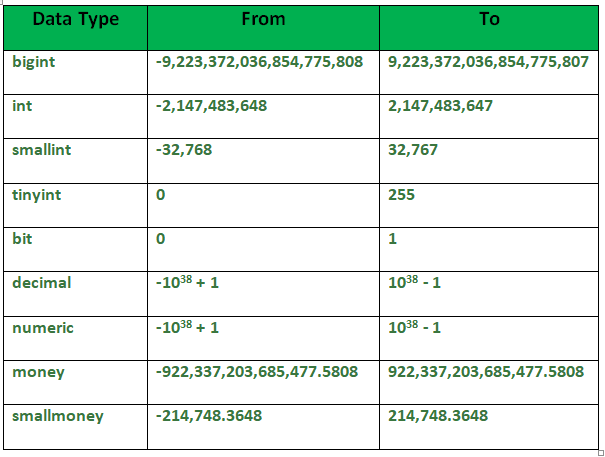
NET, C#, Entity Framework, N-tier | 159 Comments To access the value of an element, you need to know the key of the element.Implementing a generic data access layer using Entity Framework Posted: | Author: Magnus Montin | Filed under: Entity Framework, N-tier | Tags. SummaryĪ Hashtable is used to store elements which comprises of key values pairs. This method will return ‘true’ since the Value does exist in the hashtable.įrom the output, you can clearly see that both the key and value being searched are present in the hash table. We then use the ContainsValue method to see if the value is present in the hashtable.This method should return true since the key does exist in the hashtable. This method will return true if the key is present in the hashtable. First, we use the ContainsKey method to see if the key is present in the hashtable.
#Sql data type for an icollections code
Let’s change the code in our Console application to showcase how we can use the “Containskey” and “ContainsValue” method.Ĭonsole.WriteLine(ht.ContainsKey("001")) Ĭonsole.WriteLine(ht.ContainsValue("C#")) Hashtable.ContainsValue(value) Example 2: The statement will return true if the Value exists, else it will return the value false. Below is the general syntax of this statement. This method is used to see if a Value is present in the Hashtable. The statement will return true if the key exists, else it will return the value false.

This method is used to see if a key is present in the Hashtable. Let’s look at some more methods available for hash tables. If the above code is entered properly and the program is run the following output will be displayed. Next for each key value, we get the associated value in the hashtable by using the statement ht.We then assign the keys of the hashtable collection to the variable ‘keys’. This is a special data type which can be used to store the keys of a hashtable collections. This is done via the ICollection interface.In order to display the hashtable, we first need to get the list of keys (001, 002 and 003) from the hash table.There is no direct way to display the elements of a hash table.Remember that we need to add both a key and value element when adding something to the hashtable. We then add elements to the hash table using the Add method.First, we declare the hashtable variable using the Hashtable data type by using keyword “New.” The name of the variable defines is ‘ht’.In the below program, we will write the code to see how we can use the above-mentioned methods.įor now in our example, we will just look at how we can create a hashtable, add elements to the hashtable and display them accordingly. The code will be written to our Program.cs file. All of the below-mentioned code will be written to our Console application. Now, let’s see this working at a code level. Remember that each element of the hash table comprises of 2 values, one is the key, and the other is the value. The general syntax of the statement is given below HashTable.add("key","value") Example 1: The Add method is used to add an element on to the queue. Hashtable ht = new Hashtable() Adding elements to the Hashtable The object is then assigned to the variable ht. The “new” keyword is used to create an object of a Hashtable.

A Hashtable is created with the help of the Hashtable Datatype. The declaration of a Hashtable is shown below. Let’s look at the operations available for the Hashtable collection in more detail. The values of each key value pair are “.Net”, “C#” and “ASP.Net” respectively. The keys of each element are 001, 002 and 003 respectively. These 2 values form an element of the hash table.īelow are some example of how values of a hash table might look like. So instead of storing just one value like the stack, array list and queue, the hash table stores 2 values.

A hash table is a special collection that is used to store key-value items.


 0 kommentar(er)
0 kommentar(er)
